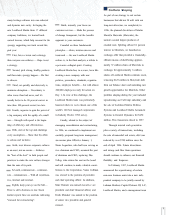Lockheed Martin 1996 Annual Report Download - page 18
Download and view the complete annual report
Please find page 18 of the 1996 Lockheed Martin annual report below. You can navigate through the pages in the report by either clicking on the pages listed below, or by using the keyword search tool below to find specific information within the annual report.
he past year was one of
monumental achievement in
the field of space science, and
Lockheed Martin was a leading player.
The discovery of possible traces of
microscopic fossils in Martian meteor
samples collected in Antarctica energized
America's space program.
By November 1996, within months
of that landmark discovery, Mars Global
Surveyor, built by Lockheed Martin
Astronautics, was enroute to Mars. The
spacecraft will reach Mars in September
1997 to compile a database on Martian
atmospheric and surface features.
Launched in December 1996, Mars
Pathfinder will land on the planet's surface
in mid-1997. Lockheed Martin built the
entry capsule which will protect Pathfinder
on its descent through the Martian atmos-
phere. Astronautics also is building two
spacecraft as part of NASA's Mars
Surveyor program that will be launched to
Mars in late 1998 and early 1999.
The Space & Strategic Missiles
Sector recorded an outstanding number of
mission successes in 1996 with its fleet
of launch vehicles. In 1996 there were
seven Atlas launches serving commercial
satellite customers; one Proton launch,
the first for the ILS International Launch
Services joint venture company with our
Russian partners; four Titan launches
carrying classified Department of Defense
payloads; and the first mission of the
Multi-Service Launch System, a reconfig-
ured Minuteman missile the U.S. Air
Force will use to launch small payloads.
Lockheed Martin's Atlas family of
launchers addresses a wide range of
medium payloads at the heart of the com-
mercial business. In April, an Atlas IIA
launched the first of the new-generation
Inmarsat communications satellites,
Inmarsat-3F1, which was built by
Lockheed Martin Telecommunications.
Also last year, through its contracting
affiliate Lockheed Martin Commercial
Launch Services, ILS signed up the first
commercial customer for the newest Atlas,
the IIAR, which is scheduled for the first
launch in late 1998. The customer, Space
Systems/Loral, has signed up for three
firm launches. In April, the first commer-
cial Proton was launched under the
auspices of ILS from Baikonur cosmod-
rome. Carrying a European Astra IF satel-
lite, the launch was a dramatic symbol of
new post-Cold War business relationships.
Just before year's end, the Air Force
also selected two of four competing
companies, including Lockheed Martin
Astronautics, to produce more detailed
designs for the new Evolved Expendable
Launch Vehicle (EELV) family of more
efficient, lower cost launchers. The Air
Force expects to select one of the two
remaining companies in June 1998 to
complete development of the new EELV
family of vehicles that are intended to
replace the existing Delta, Atlas and
Titan space launch vehicles for use in
launching a wide range of government and
commercial payloads. The potential of
this award is in the billions of dollars.
And as an impressive symbol of
Lockheed Martin's leadership in the space-
based telecommunications arena, three
Lockheed Martin Telecommunications
satellites were launched in September in a
span of just five days from three different
continents, aboard three different launch
vehicles — an industry record. Two of the
satellites were lofted into space aboard
Lockheed Martin launch vehicles. One of
the satellites, GE-1, built for GE
Americom, was the first based on the
advanced A2100 satellite bus designed
and manufactured by Lockheed Martin
Missiles & Space.
Made totally of lightweight compos-
ites, the A2100 is modular in design,
affording a simplified and more flexible
assembly process. As a result, the A2100
can be configured to meet customer
needs without costly reengineering. The
A2100 offers the most payload power per
kilogram of any production satellite and is
designed to deliver a solid 15-year mission
life. It is the heart of the total system
solutions offered by Lockheed Martin
Telecommunications in the direct broad-
cast, mobile telephony, broadband and
fixed satellite system markets.
The A2100 will be the satellite for
the Asia Cellular Satellite (ACeS) system.
When operational in 1999, ACeS will
allow users in Southeast Asia, China and
India to access voice, facsimile and paging
services through hand-held mobile and
fixed telephones. ACeS is indicative of
the complementary capabilities across the
breadth of the Corporation. Aside from
providing the satellite, Lockheed Martin
Space & Strategic Missiles
























